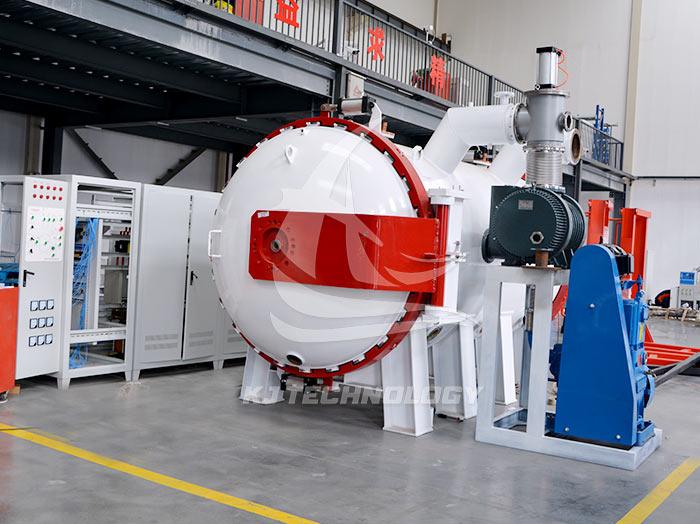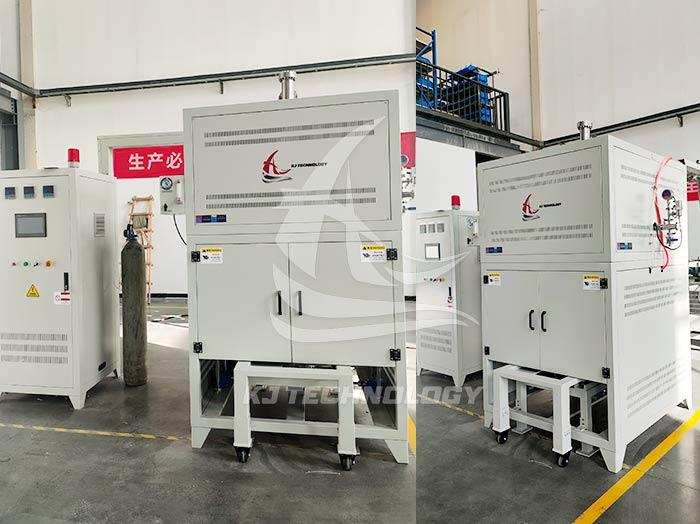Principle of gas quenching furnace
 10-27-2025 Author: KJ technology
10-27-2025 Author: KJ technology
The core principle of gas quenching furnace is to achieve rapid cooling of metal workpieces through high-pressure gas circulation flow. Its working process can be divided into three stages: vacuum heating, gas filling and circulation, and quenching cooling. The specific introduction is as follows:
workflow
Vacuum heating stage: The workpiece is heated to the quenching temperature in a vacuum environment. A vacuum environment can prevent oxidation of workpieces during heating, ensuring their surface quality. For example, in the aerospace field, materials such as titanium alloys have significantly improved surface smoothness after vacuum heating, meeting the requirements of precision manufacturing.
Gas filling and circulation stage: Fill the furnace with high-pressure gas (such as nitrogen) and start the fan to circulate the gas. The gas is cooled through a heat exchanger to form a low-temperature airflow. For example, in the automotive industry, workpieces such as transmission gears are heated in vacuum and cooled by high-pressure nitrogen gas. The fan ensures uniform gas flow and avoids local temperature differences.
Quenching and cooling stage: The cooled gas is evenly supplied to the surface of the workpiece through an air duct, achieving rapid cooling. High pressure gas cooling is more uniform than liquid cooling, and can uniformly cool from the surface to the inner layer, reducing workpiece deformation. For example, in mold manufacturing, after gas quenching, the thermal distortion of die-casting molds is controlled within a very narrow range, and the dimensional accuracy is significantly improved.
key technology
High pressure gas quenching technology: By adjusting the gas pressure (0.5-2MPa) and flow rate, the cooling rate is controlled. For example, alloy steel carburized parts need to maintain a pressure of at least 1MPa and have good gas heat exchange and flow circulation conditions to achieve the cooling rate of oil quenching when cooled in gas.
Computer control technology: By using computer programs to control gas flow rate, pressure, and direction, the cooling characteristics of the gas can be altered. For example, using small air flow in the martensitic transformation zone to reduce quenching distortion of the workpiece; Isothermal retention near the Ms point reduces the temperature difference between the surface and the core of the part, and lowers the stress distortion caused by martensitic transformation.
Gas recovery technology: using nitrogen and hydrogen recovery technology to reduce processing costs. For example, high-pressure gas quenching furnaces, through gas recovery technology, significantly reduce costs and promote the popularization and promotion of mixed gas quenching technology.
Application advantages
Reduce deformation: Uniform gas cooling can achieve uniform cooling from the surface to the inner layer, reducing workpiece deformation. For example, in the treatment of automotive transmission gears, gas quenching reduces the average value of tooth profile distortion and outer diameter distortion.
Clean and environmentally friendly: High pressure gas quenching uses neutral gases (such as nitrogen), reducing gases (such as hydrogen), and inert gases (such as argon and helium), which are discharged into the atmosphere without pollution, avoiding smoke pollution caused by oil quenching, and eliminating the need for alkaline cleaning processes and oily liquid discharge.
Flexible process: By adjusting the gas pressure and gas velocity, the quenching strength can be adjusted according to the requirements of the parts. For example, in the aerospace field, nickel based high-temperature alloys can achieve ideal metallographic structure and effective hardening layer depth after gas quenching.
Integrated production: can be integrated into the production line to achieve mass production. For example, in the automotive industry, high-pressure gas quenching can use single chamber, double chamber, and three chamber low-pressure carburizing and high-pressure gas quenching vacuum cycle furnaces, as well as multi chamber low-pressure carburizing and high-pressure gas quenching production lines to improve production capacity and reduce heat treatment costs.








